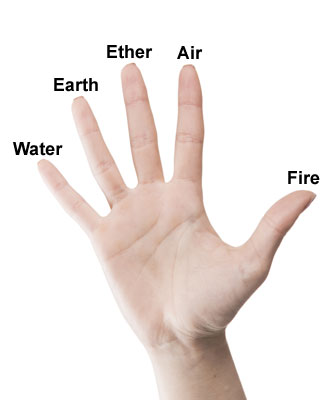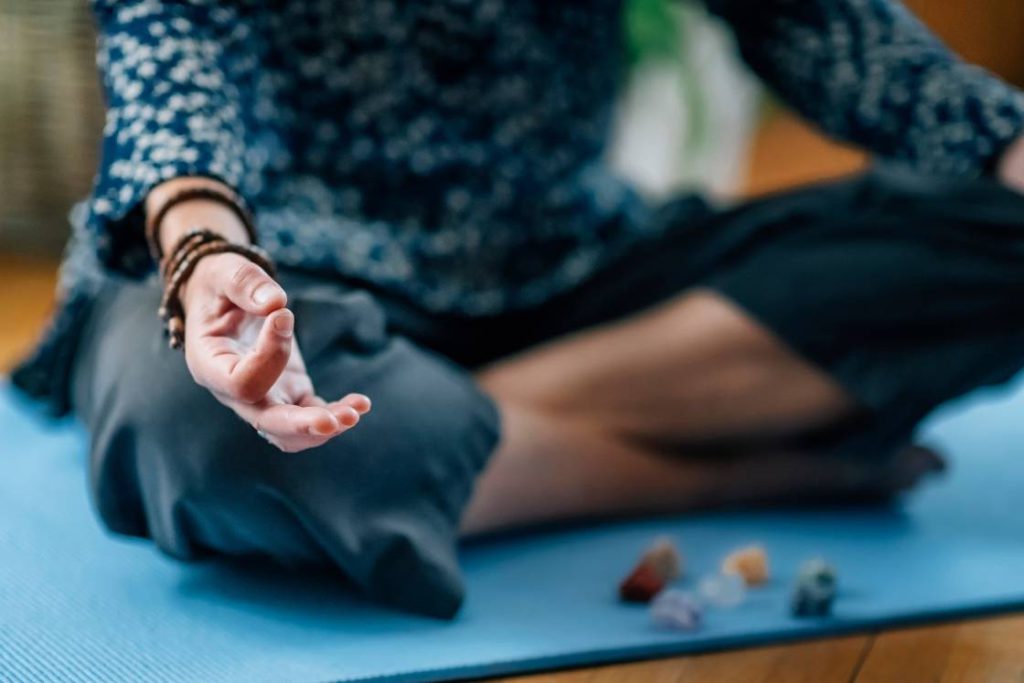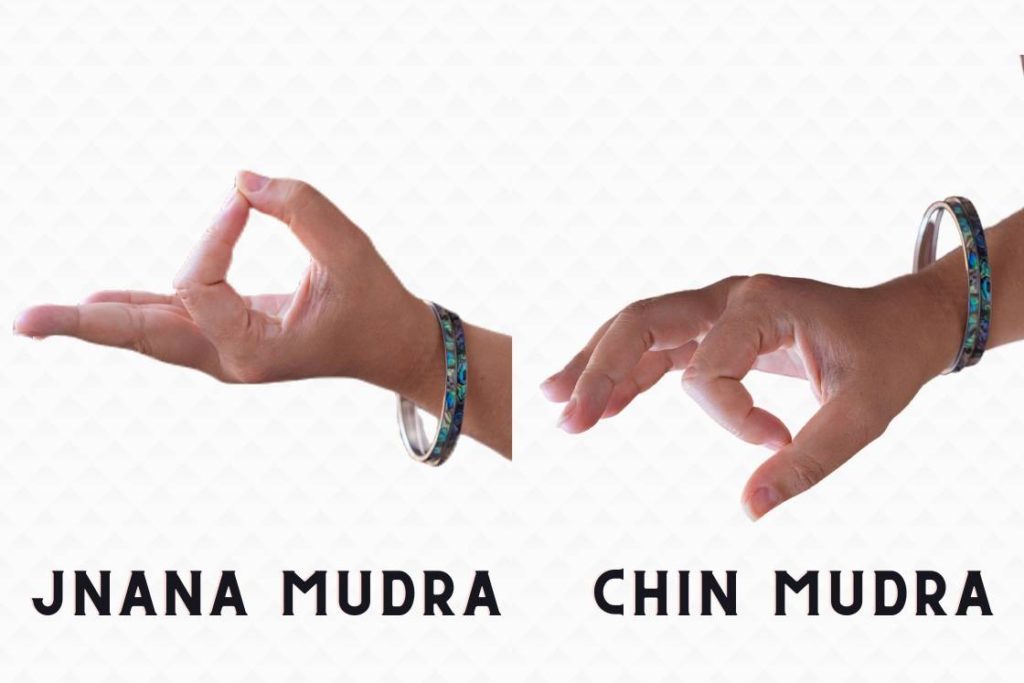
Jnana” means “knowledge” in Sanskrit. In yoga, this knowledge is about gaining deep wisdom and understanding about ourselves and the world. One of the simple and effective ways to achieve this understanding is by using Jnana Mudra.
Jnana Mudra is a hand gesture often used during meditation, yoga poses, and breathing exercises. To do this gesture, you touch the tip of your index finger to the tip of your thumb while keeping the other fingers straight. This helps you focus inward, calm your mind, and get ready for meditation. By doing Jnana Mudra, you can gain deeper knowledge, which is why it’s also called Gyan Mudra
Meaning
The word “Jnana” comes from Sanskrit and means “knowledge” or “wisdom.” “Mudra” is a combined term where “mud” means “delight” or “pleasure,” and “dravya” or “dru” means “to draw forth.”
In prana yoga, the index finger represents the Vayu (air) element, which is linked to an unsteady mind. The thumb represents the Agni (fire) element. Jnana Mudra helps balance the air element with the fire element, which stabilizes the mind. A stable mind can achieve wisdom, which is why this gesture is called Jnana Mudra, or the “gesture of knowledge.”
Additionally, when the air element (Vayu) comes into contact with the fire element, its efficiency increases, which is why Jnana Mudra is also known as ‘Vayu Vardak Mudra.’
Symbolic Interpretation

In Jnana Mudra, each finger represents one of the five elements. The index finger and thumb touch each other, symbolizing the air (Vayu) and fire (Agni) elements working together. The other three fingers stay straight, each with a special meaning:
- Little Finger (Tamas Guna): Represents stability.
- Ring Finger (Rajas Guna): Represents activity and creativity.
- Middle Finger (Sattva Guna): Represents harmony and brightness.
Jnana Mudra helps us go beyond these three qualities to move from ignorance to knowledge. The index finger stands for our own consciousness(jivatma), and the thumb stands for the supreme consciousness. When they touch, it shows the connection between our individual self and the universal spirit, which is a key idea in yoga. This gesture is also known as the “Mudra of Wisdom“.
Doing Jnana Mudra can calm and stabilize the mind and improve memory and focus.
Ayurvedic and chakra connections
Ayurvedic Elements: Jnana Mudra activates the ether element, which is linked to space and openness in the body. Balancing this element helps improve spontaneity, honesty, and alignment with one’s goals. The gesture also helps balance the air and fire elements, which supports mental stability and clearer thoughts.
Chakras: Jnana Mudra is connected to the Root Chakra (Muladhara) and the Third Eye Chakra (Ajna). It helps energy flow between these chakras, which supports spiritual insight and grounding. By activating these chakras, Jnana Mudra strengthens the connection between your inner self and higher consciousness.
How to do jnana mudra(steps)

- Sit comfortably in a meditative posture like Padmasana or Sukhasana.
- Rest your hands on your knees or thighs with palms facing up.
- Touch the tip of your index finger to the tip of your thumb.
- Keep the other three fingers extended and straight.
- Ensure your arms and hands are relaxed.
- Close your eyes and focus on your breath, turning your awareness inward.
- Hold the position for at least 15 minutes during meditation, yoga, or pranayama.
- Gently release your fingers and bring your hands back to your lap when finished.
Time duration
- Best Time: Morning is ideal for practicing Jnana Mudra.
- Duration: Aim for at least 15 minutes per session, 2-3 times a day for optimal benefits.
- Extended Use: For addressing specific issues such as insomnia or stress, extend practice up to 50 minutes, potentially combined with Prana Mudra.
Precautions
- Keep your hands relaxed and free of tension.
- Ensure your arms and hands are within the boundaries of your knees.
- Lightly touch the tip of the index finger to the thumb without applying excessive pressure.
- Keep the other three fingers extended and slightly apart.
- Sit comfortably without straining.
Contraindications
- Seek advice from a yoga expert if you suffer from insomnia before practicing.
- Pregnant women should practice Jnana Mudra only under expert guidance and avoid long durations.
- Consult a healthcare provider if you have medical conditions affecting your hands or wrists.
- Avoid overusing the mudra to prevent discomfort or strain.
Mechanism of Jnana mudra
When performing Jnana Mudra, the lock created by touching the index finger to the thumb forms a circuit that directs energy inward. This prevents the energy from dissipating into the environment during meditation.
The fingers have numerous nerve endings that continuously release energy. By locking the fingers together, this energy is contained within the body and directed towards the brain.
Another pranic circuit is formed when the hands are placed on the knees, redirecting prana internally. This placement stimulates the knees, inner thighs, and perineum, which is associated with the hidden (Gupta) Nadi. Activating the Gupta Nadi, in turn, stimulates the Muladhara Chakra, promoting grounding and increased awareness.
Jnana vs. chin mudra

Despite having the same finger arrangement and hand placement, Jnana Mudra differs from Chin Mudra.
According to Swami Muktibodhananda’s commentary on the Hatha Yoga Pradipika:
- In Chin Mudra, the index finger is bent down to touch the root of the thumb, while the other three fingers remain straight and separated. In contrast, in Jnana Mudra, the tip of the index finger touches the tip of the thumb, forming a uniform circle that represents the knowledge wheel.
- Another difference lies in the placement of the hands on the knees. In Chin Mudra, the hands rest on the knees or thighs with palms facing down, which provides a grounding effect on the mind. On the other hand, in Jnana Mudra, the hands are placed on the knees with palms facing up during seated meditation, creating a sense of spaciousness and a subtle uplifting effect on the body and mind.
Jnana Mudra Benefits
Jnana Mudra is a powerful hand gesture that enhances both mental clarity and physical well-being. Touching the tips of your index finger and thumb together creates a loop that focuses energy inward. This practice boosts concentration, supports spiritual growth, and maintains balance. Regular use enhances meditation, clarity of thought, overall health, and emotional stability.
- Improves Concentration: Jnana Mudra helps you focus better by directing your energy inward. When you touch the tips of your index finger and thumb together, it creates a loop that helps you concentrate. This makes it easier to pay attention, remember things, and think clearly.
- Promotes Enlightenment: This mudra helps connect you with higher spiritual energy. By doing Jnana Mudra, you align yourself with deeper awareness, which can help you understand yourself and the world better. It supports your journey toward spiritual growth and enlightenment.
- Strengthens Muscular System: Practicing Jnana Mudra with deep breathing helps boost energy flow in your body. This extra energy improves oxygen supply to your muscles, which makes them stronger and more enduring. This helps keep your muscles healthy and full of vitality.
- Enhances Endocrine System: When you press the tip of your index finger to your thumb, you stimulate points related to important glands in your body. This can help regulate hormones, which is good for both your physical and emotional health.
- Calms the Mind: Jnana Mudra helps you focus your mind by reducing outside distractions. This focus helps calm your thoughts, easing stress and anxiety. It creates a sense of relaxation, helping you feel more peaceful and balanced.
- Supports Overcoming Addiction: This mudra helps balance both sides of your brain, which can improve your willpower and self-control. By doing Jnana Mudra, you can become more aware and better manage urges, which can be helpful for overcoming addiction.
Conclusion
Jnana Mudra is a simple but effective practice that helps you improve your wisdom, focus, and relaxation. Doing this gesture regularly can make your meditation deeper, improve your thinking, and help you feel emotionally balanced. Adding Jnana Mudra to your daily routine can lead to better concentration, spiritual growth, and overall harmony in your life.





REFER TO GHERANDHA SAMHITA AND IT SAYS REVERSE! GYANA MUDRA PALMS FACES DOWNWARD AND CHINMUDRA FACES UPWARDS!